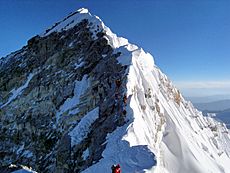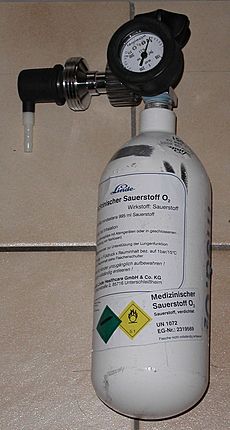Death zone facts for kids

In mountain climbing, the death zone is a very high area where there isn't enough oxygen for people to live for a long time. This zone usually starts above 8,000 m (26,000 ft). At this height, the air pressure is very low.
A Swiss doctor named Edouard Wyss-Dunant first described this idea in 1953. He called it the "lethal zone." All 14 of the world's highest mountains, known as "eight-thousanders," are in this death zone. They are found in the Himalaya and Karakoram mountain ranges in Asia.
Many climbers have died in the death zone. This happens because their bodies can't get enough oxygen. It can also lead to bad decisions or accidents, like falling. Staying above 8,000 m (26,000 ft) without extra oxygen will cause your body to fail. Eventually, it leads to death.
Contents
How High Altitude Affects Your Body
Your body works best near sea level. The air we breathe has about 20.9% oxygen. So, at sea level, there's plenty of oxygen for your red blood cells.
As you go higher, the air pressure drops. The amount of oxygen in the air stays the same, but there's less of it to breathe in. For example, at the Mount Everest base camp (5,500 m (18,000 ft)), there's only about half the oxygen compared to sea level. At the top of Mount Everest (8,849 m (29,032 ft)), there's less than one-third.
Your Body's Response to Altitude
When there's less oxygen, your body tries to get used to it. This process is called acclimatization. Your body makes more red blood cells to carry oxygen. Your heart beats faster, and you breathe more deeply and quickly. Your body also slows down less important functions, like digestion.
But getting used to high altitude takes days or even weeks. If your body can't acclimatize, you can get altitude sickness. This can include serious conditions like high-altitude pulmonary edema (HAPE) or cerebral edema (HACE). These affect your lungs and brain.
People have lived for two years at 5,950 m (19,520 ft). This seems to be the highest altitude where people can live permanently. Above 7,500 m (24,600 ft), it becomes very hard to sleep or digest food. The risk of HAPE or HACE also goes up a lot.
In the death zone and higher, your body cannot fully adapt. You use up oxygen faster than you can take it in. Staying in this zone without extra oxygen will make your body fail. You can lose consciousness and eventually die.
Some scientists, however, question the idea of a "death zone." They have studied people who can tolerate very low oxygen levels. These include people with chronic mountain sickness.
Using Oxygen to Survive
Mountaineers often use extra oxygen in the death zone. This helps them avoid the dangerous effects of low oxygen. The first time bottled oxygen was tested on Mount Everest was in 1922.
In 1953, Ed Hillary and Tenzing Norgay were the first to reach the summit of Everest. They used extra oxygen. Hillary said he became "clumsy-fingered and slow-moving" after just ten minutes without his oxygen on the summit.
A physiologist named Griffith Pugh studied how cold and altitude affect climbers. He suggested that climbers should spend at least 36 days getting used to altitudes above 15,000 ft (4,600 m). He also recommended using special oxygen equipment.
In 1978, Reinhold Messner and Peter Habeler were the first to climb Mount Everest without any extra oxygen. This was a huge achievement.
See also
 In Spanish: Zona de la muerte para niños
In Spanish: Zona de la muerte para niños
- Effects of high altitude on humans
- Hypoxemia
- Hypoxia (medical)


